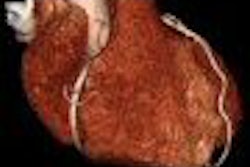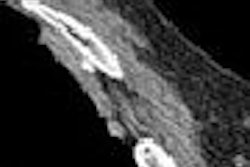WASHINGTON, DC - After reviewing the frequency and application of CT studies in its emergency department, researchers at Yale New Haven Hospital in New Haven, CT, are recommending the "serious consideration" of alternative imaging methods to lower patients' radiation exposure.
They presented the results of three related studies at the annual meeting of the American Roentgen Ray Society (ARRS) on Monday.
While CT images provide good anatomic detail, the modality exposes patients to radiation and its deleterious effects, which can result in cancer or genetic mutations. An effective radiation of dose of 10 mSv can cause an increase in the lifetime cancer risk in one in 2,000 patients.
Lifetime risk
In the first study, the Yale New Haven researchers sought a way to help emergency department physicians identify patients with high cumulative radiation from previous scans and possibly assign a "rad value" to those patients. Based on a patient's prior exposure to radiation, the physician might consider another modality to diagnose diseases or the cause of patient symptoms.
The study analyzed CT scans performed in the Yale New Haven Hospital emergency department for the month of February 2007. "For each of these patients, we looked at all prior CT studies since 1997, since that was when we started our PACS," said Dr. Meghna Krishnan, a resident at Yale New Haven, during her ARRS presentation.
Patients were divided into four age groups:
- Group 1: younger than 20 years old
- Group 2: 20 to 35 years old
- Group 3: 36 to 64 years old
- Group 4: 65 years old and older
Of the 1,019 patients in the study (497 men, 522 women), 39% comprised group three, 24% were in group four, 22% in group two, and 15% in group one. The mean cumulative effective radiation dose was highest in group two (39 mSv), followed by group one (36 mSv), group three (23 mSv), and group four (19 mSv).
The study found that the mean cumulative effective radiation dose was higher in males (32 mSv) compared to females (23 mSv) in all four age groups. The gender difference was greatest in group two, with the mean cumulative dose among men at 46 mSv, compared with 31 mSv among women.
Based on those results, patients younger than 36 years old, especially men, had the highest mean cumulative effective radiation dose from CT studies in the past 10 years.
"If 10 mSv increase the lifetime risk level in at least one in 2,000, if an average young individual is going to carry 40 mSv and walk around the planet, their lifetime risk of cancer increases four times," Krishnan said.
With younger patients receiving higher cumulative effective radiation doses than older patients over that time, "serious consideration should be given to alternative methods to decrease the lifetime risk of deleterious effects of ionizing radiation, including cancer," she added.
Low yields
In the second study, the researchers sought to compare the cumulative effective radiation dose and yield of positive diagnoses across the four patient age groups, and demonstrate if younger patients receive the highest share of radiation with the lowest yield of positive diagnoses.
The analysis found that 75% of the 1,094 CT studies performed on 970 patients in February -- which comprised 65% of the total administered radiation -- yielded negative diagnoses. Among the various CT studies, CT pulmonary angiography demonstrated the lowest yield of positive detections, followed in order by CT aortic dissection, CT head and neck, and CT flank pain studies.
Patients in group three (36 to 64 years) had the lowest yield of positive findings, followed in order by groups two (20 to 35 years), one (younger than age 20), and four (65 years and older). Group three received 38% of the total radiation, followed by patients in group two with 25%, group four with 22%, and group one with 10%. The mean effective radiation dose also was significantly higher in group three (9.6 mSv) than in the other groups: 8.7 mSv in group four, 8.5 mSv in group two, and 7.3 mSv in group one.
The mean effective radiation dose in males (9.1 mSv) among all age groups was significantly higher than females, who had a mean effective radiation dose of 7.9 mSv.
Again, because of the high level of incidence, the study advocates other imaging modalities to decrease the lifetime risk of cancer.
CT efficacy
The third study presented at the ARRS meeting compared the cumulative effective radiation dose and the number of positive diagnoses from CT pulmonary angiography in the emergency department.
Using the same parameters and patient age groups as the other two studies, researchers reviewed 81 CT pulmonary angiography studies. Forty-two studies were performed on group three (36 to 64 years), 21 in group two (20 to 35 years), 15 on group four (65 years and older), and three studies in group one (younger than age 20). Women underwent 81% of the procedures.
In the analysis, 79 (98%) of the CT studies did not yield a positive diagnosis. However, 21 (34%) of the CT studies identified alternative, clinically relevant findings. Only two patients from groups three and four had positive findings.
When compared with other CT studies performed during the same time period, CT pulmonary angiography demonstrated the lowest yield of detecting positive findings. The mean effective radiation dose per patient was 6.9 mSv. Of the cumulative effective radiation dose of 588 mSv administered within CT pulmonary angiography, 97% of the studies did not demonstrate a positive identification of pulmonary embolism.
CT pulmonary angiography contributed to 13% of the total administered radiation among all the CT studies that did not yield a positive finding.
As for which modality may be best suited to replace CT, Krishnan said it is a difficult question to answer. "We have to work on it, because the imaging quality of a CT cannot be compared to what we have at this point," she added, "but we should try to do more research, maybe in MR, so we can help patients."
By Wayne Forrest
AuntMinnie.com staff writer
April 15, 2008
Related Reading
ACC news: CTA dose varies widely, could be lower, April 2, 2008
Prospective gating drops cardiac CT radiation dose, March 10, 2008
New studies examine CR, CT radiation dose, March 9, 2008
Dose studies delve into coronary CTA, March 8, 2008
Low-dose coronary CTA diagnoses most patients, November 28, 2007
Copyright © 2008 AuntMinnie.com



















